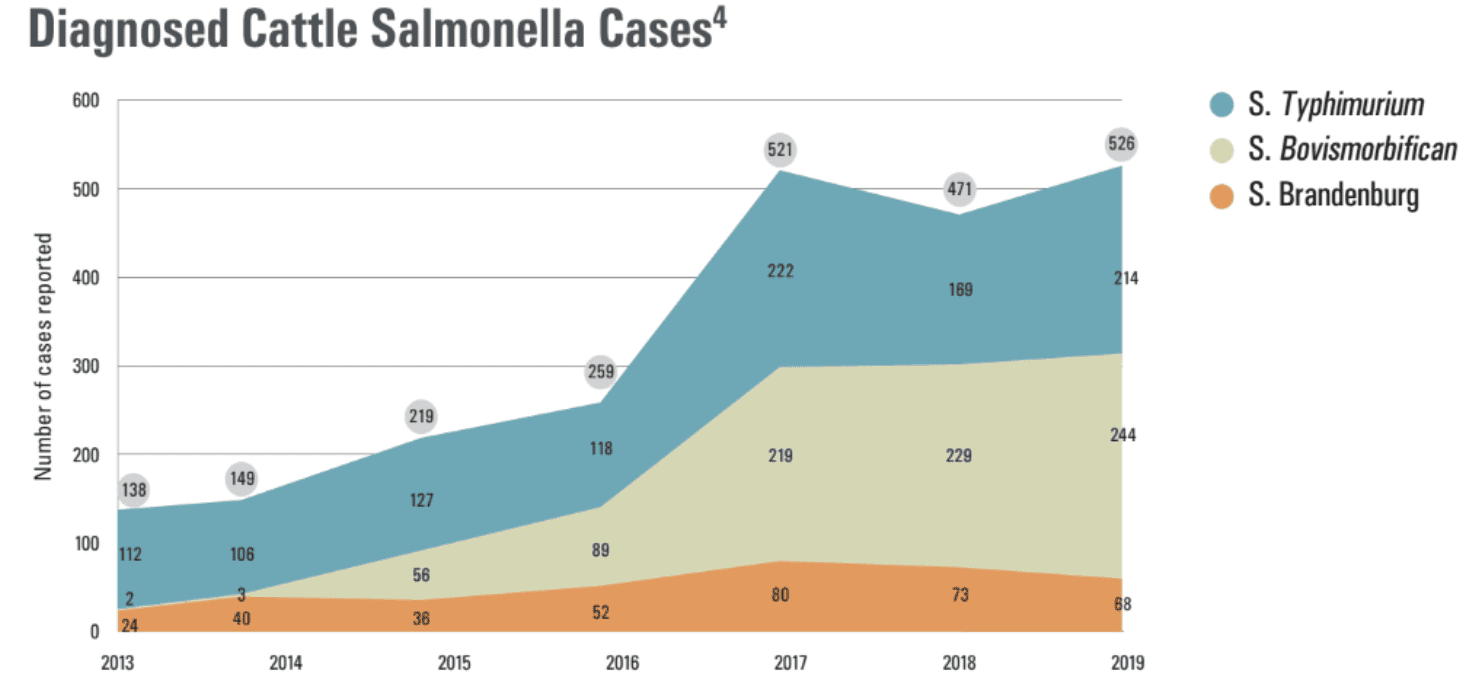Salmonella
Salmonella is a significant disease of cattle and sheep and it is increasing in prevalence. Usually striking without warning and spreading rapidly, the effects of Salmonella are devastating. Moreover, it can make you, your family and your staff very sick too. Since 2014 there has been a marked increase in S. bovismorbificans in cows and calves, from a handful of cases to 281 in 2019. Illness and death rates have been seen of up to 46% & 8% in dairy herds and 75% & 50% in calves. There has also been a rise in human cases, and some in sheep. Several sheep farms sharing a river saw salmonella enteritis and deaths after shearing in 2019, possibly due to contaminated water and stress.
S. bovismorbificans outbreaks in people have been associated with sprouted seeds and salads, so they are potentially adapted to soil and watery habitats. Some isolates in Australian sheep have also displayed hypervirulence, where the bacteria become more infectious and lethal after passage through an animal.
Salmonella is spread by healthy carrier animals which don’t show signs of disease, but shed bacteria (usually intermittently or at low levels). These bacteria go on to infect other animals. Carrier animals can shed Salmonella for months or even years. It is spread by infected materials (e.g. faeces, aborted materials) which can be further spread by
scavenging animals such as seagulls or hawks. Salmonella can survive in the environment for a long period of time (e.g. months to years in ideal conditions like wet paddocks, or dry, shaded areas such as cattle or sheep yards). Conversely, it can be killed in days with freezing or heating.
Strains of Salmonella
Cattle
• Brandenburg (primarily causes abortions)
• Typhimurium (primarily affects the gut)
• Bovismorbificans(primarily affects the gut)
Sheep
• Hindmarsh (primarily affects the gut)
• Brandenburg (primarily causes abortions)
Irrespective of the strain, all types of Salmonella
can cause outbreaks and deaths (5% in cattle and sheep).
Outbreaks happen when ingestion of an infective dose of Salmonella occurs at the same time as stress and a change in feed type or quality. Stress can be caused by stock movement or handling, bad weather, or calving/lambing. Usually, Salmonella would already be circulating or being shed at low levels in the flock/herd, but the diet change causes a change in the animals’ gut
environment (for example, an increase in pH or reduced production of volatile fatty acids). This reduces the number of bacteria that need to be ingested to cause illness and/or increases the number of Salmonella shed by carrier animals.
At the same time, stress, late pregnancy or immune suppression make the animals less able to fight off infection. It is at this time that animals become sick or abort; sick animals shed more Salmonella into the environment,
which can infect other naïve flock/herd mates, perpetuating the outbreak.
Environmental conditions (such as wet weather) may also contribute, as it will favour Salmonella survival in the
environment and/or help spread Salmonella around. Removal of aborted material is essential as this a good source of bacteria
The most common way Salmonella is introduced to a farm is through healthy looking carrier animals (cattle, sheep etc.).
Higher risk practices include:
• Off-farm grazing
• Intensive feeding
• Purchasing/leasing stock
• Shared boundaries/stock yards
So, reduce risk by:
• Minimise time off feed when yarding/transporting
• Clean and disinfect yards between groups of animals
• Separate stress events
• Control pests and scavengers
• Vaccinate at-risk animals prior to stress events or diet changes
• Double check Magnesium supplementation forms/ rates (cattle)

